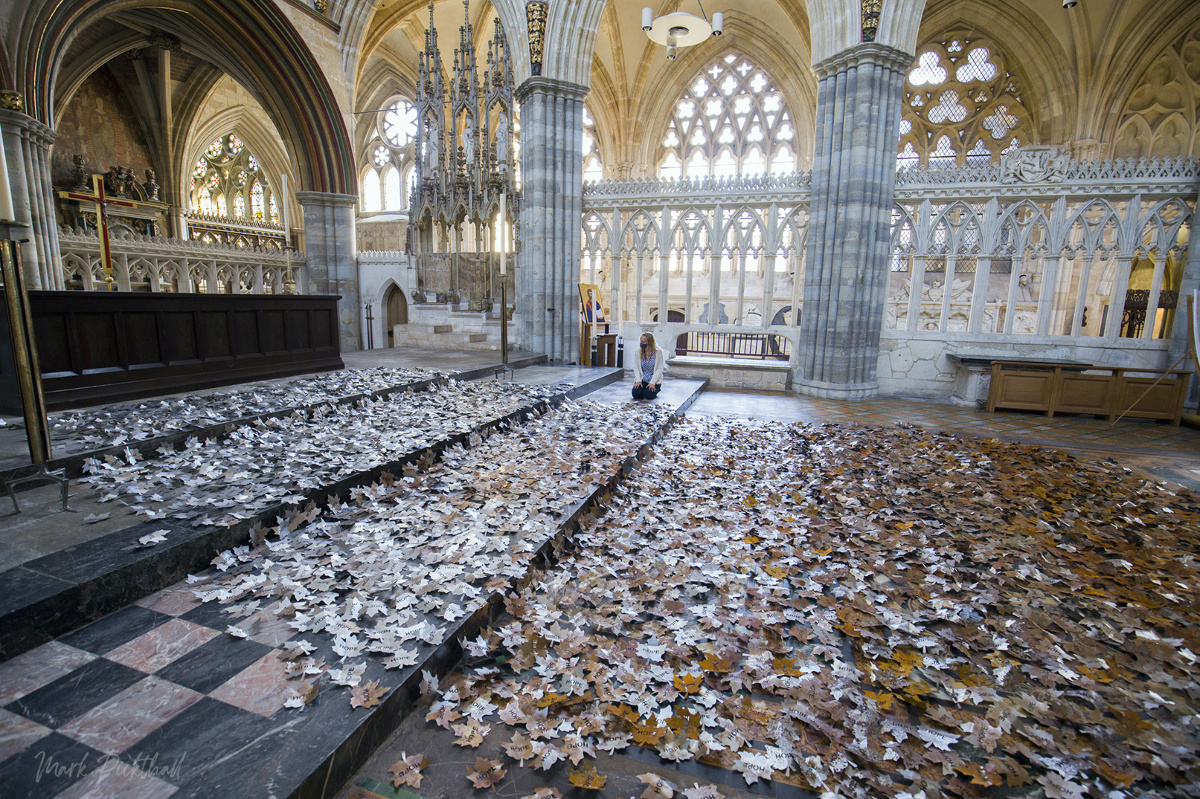
ANGELA YOUNGMAN reports on how UK cathedrals are using art installations to engage with congregations and visitors…
UK
Head into a UK cathedral and there is every chance that you are going to encounter art works designed to make you think and reflect. They may be situated in the nave, in chapels, cloisters or hanging from the rafters. As sculptor Peter Walker, artist-in-residence at Lichfield Cathedral, puts it: “There is a renaissance of art in UK cathedrals. It is not artwork for galleries or museums but for sacred spaces.”
Ever since the first churches and cathedrals were built, there has been a desire to beautify them in honour of the Lord. Artists and craftspeople ornamented stonework, created paintings, decorative gold and silverwork. On the continent, this practice has continued unabated, leading to the glories of work by artists like Michelangelo and Raphael. The Reformation ushered in by Henry VIII brought an end to this practice in the UK.
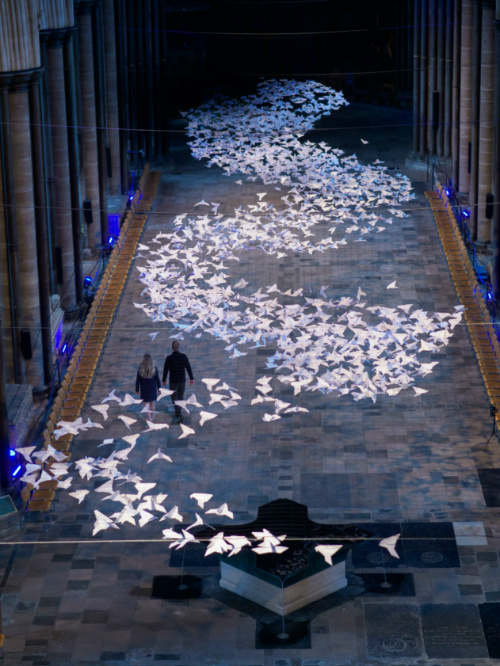
Les Colombes at Salisbury Cathedral in 2018, a view from Triforium. PICTURE: Courtesy of Salisbury Cathedral.
“Art has to open ideas to people. You get people who come to services who might not get a piece of art, others do. It can be a no mans land, edgy art that makes you slightly uncomfortable and questioning. It is a way of opening up conversations.”
– Canon Rev Robert Titley at Salisbury Cathedral.
For centuries, the concept of art in cathedrals fell into disuse slowly beginning to reappear during Victorian times with greater emphasis on stained glass, memorials and architectural features. With the onset of the 21st century, however, the UK’s Church of England cathedrals are once again becoming renowned for their adoption of all forms of contemporary art whether linking back to its heritage, or seeking to provoke reflection and thought.
Salisbury Cathedral has been one of the leaders in this adoption of contemporary art displays, with projects involving inmates from the local prison, works by well known names like Anthony Gormley and Elizabeth Frink, works exploring creation through embroidery or even origami doves. The latter – a massive origami installation of doves, the symbol of peace – were located within the cathedral in the aftermath of the traumatic Novichok saga and prompted people around the city to create their own origami doves and display them all over the city.
Canon Rev Robert Titley comments: “Art has to open ideas to people. You get people who come to services who might not get a piece of art, others do. It can be a no mans land, edgy art that makes you slightly uncomfortable and questioning. It is a way of opening up conversations.”
“The feedback we have had about the art installations is that the majority like it. Some felt they might not like one, but would like a different one. It might not be my style, doesn’t work for me but will for others. We always aim for an element of shock and surprise because that is central to the Gospel. Being too soothing, would be short selling the Gospel.”
In Lichfield, Peter Walker says that cathedrals are a “living, breathing space”.
“People go to light a candle, drop in at lunchtime, stop to pray, listen to music as well as take part in services,” he says. “We looked at how people use the cathedrals, what they think of art and their responses. We have to bear in mind the different ways people use cathedrals – liturgical space, contemplation, a place of calm or seeking help.”
At the start of his appointment as artist-in-residence, he sat down with the Dean to discuss the new partnership. As historic buildings, there are limits on what can be done due to the need to preserve the building. Art cannot be fixed to walls, for example, it has to be presented in standalone installations.
“The cathedral is a place where art was created 800-900 years ago,” observes Walker. “It now has to be seen from a contemporary perspective and we have to create work for that space; introduce new people to the building. Art has given us national coverage, and the Archbishop of Canterbury [Justin Welby] has described us as ‘the most imaginative cathedral’.”

Peter Walker’s installation Leaves of Trees at Exeter Cathedral. PICTURE: M Pickthall
Some of Walker’s works have been on view in other cathedrals such as the Leaves of Trees exhibited in Exeter and Peterborough cathedrals, and light illuminations through his work with Lux Muralis.
Spiritual values often form part of this new ecclesiastical contemporary art.
Reflecting on his Leaves of Trees installation involving 5,000 steel leaves each bearing the word hope, Walker says the leaves symbolise the past, “but also hope for the future”.
“The sycamore maple leaves symbolise strength, protection, eternity and clarity. I chose steel because it reminds us of our resilience and collective strength. The artwork will tour the country and the steel will age, rust and change colour just as the leaves of trees do when they fall each year as part of the cycle of life that leads to the spring and new growth. The overall impression we want to give is one of hope.”
Over in Chester, Aleta Doran, artist-in-residence at the city’s cathedral says it is “a joy to spend time in such a beautiful and inspiring building”.
“I never tire of the mosaics, carvings and stained glass, and there is always something new to discover as I wander around with my camera and sketchbook. I try to be respectful to the building, emphasising my relationship to the artists of the past, and link them to modern life. This can help people today to understand, and be more respectful to the building and its art. It is a continuation of what has gone before, brought up to date. People do appreciate it, seeing the building in different ways.”
We rely on our readers to fund Sight's work - become a financial supporter today!
For more information, head to our Subscriber's page.
Whatever the type of art, the general consensus is that it is an important means of engaging with the widest possible audience – clergy, congregation, local people and tourists, Christians, non-Christians and people of no faith at all.
Jacquiline Cresswell, an artist, visual art advisor and curator responsible for the development of visual arts programs at Salisbury, Ely and Chichester, says that when she first started working at Salisbury in 2008, “we adopted a broad approach, with a lot of flexibility in the way we would engage and challenge people”.
The aim was to be inclusive, reaching beyond the church, engaging with people outside fixed events. Art links the building, spiritual issues and social action mission. It is a way of exploring our shared humanity. It can be transformative in these spaces.”
She recalls a project with inmates at the local prison in 2015.
“It was the year we were also celebrating the Magna Carta. We held discussions and workshops in the prison exploring what the Magna Carta and art meant to them, about power, justice, right and wrong. It was interesting to see just how creative they could be. Forty-five prisoners created encaustic tiles, a visual underpinning of our discussions and a way for them to express their feelings. We put a montage of the tiles and their drawings in the cathedral and later it was moved to the prison visitor centre. Prisoners said they felt they had been respected, their voices heard for the first time and began to believe that they had something to say.”
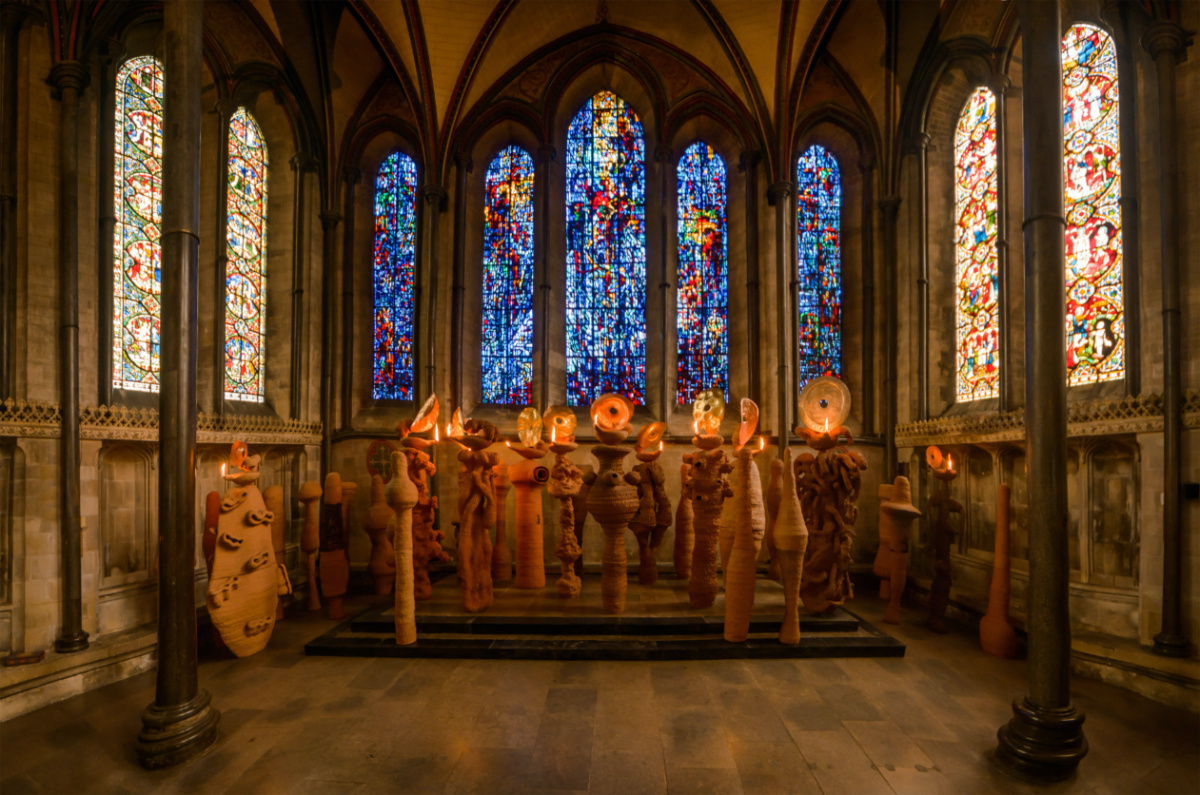
‘The Apostles Speaking in Tongues Lit by Their Own Lamps’, by the sculptor Nicholas Pope, exhibited in Salisbury Cathedral in 2014. PICTURE: Supplied.
The arrival of the COVID-19 pandemic led to cathedrals closing their doors for a time. The difficulties of life since then – and the personal worries that people are experiencing, have further transformed artistic responses. Walker says he’s noticed a change among those visiting.
“We have noticed that the younger generation are coming in more, they are less occupied with filming everything, and more with appreciating, watching and listening. Families are coming in, they sit, light a candle and say a prayer.”
In Chester, Doran says that while part of the idea of an artist-in-residence was that she would be engaging with people and working with them, COVID had put a stop to it.
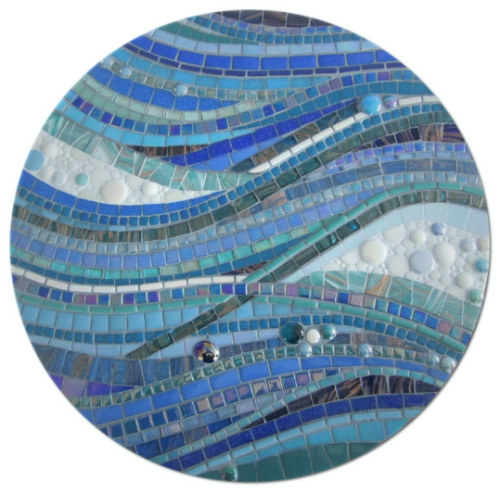
Aleta Doran’s Water is Life. PICTURE: Supplied.
“I was shielding and all contacts had to be limited. Pre-COVID I had been working with groups of children on a big fish sculpture linking to the theme of water, and the symbol of the early church. It was going to be put into the children’s area, but the area was closed to create a COVID testing centre. We haven’t been able to access it properly to install it yet.”
Doran is currently preparing for a new exhibition located in the chapter house. Entitled Constellations, it involves art works from mosaic artists across Europe and the US.
“We needed something big to come back with after COVID. I had taken up star-gazing during lockdown, and that was part of the impetus for this exhibition. It will also have an online version of the exhibition for people who cannot get there. We realised this was an important aspect, something that has been learned during lockdown. People cannot travel, but this way they can see the exhibition. It opens it up to a wider audience, and gives us an international reach.”
“Constellations was chosen because it is can be interpreted in many ways, and has links to the cathedral as stars, scenes from the heavens, angels, star signs can be seen all over the cathedral. One of the projects on display will be Ethereal, an artistic collaboration with artists supplying small tiles; many using recycled objects and linking with environmentalism, recycling and the effects on the heavens. We hope to have 165 of these, all hung together in the cloister.
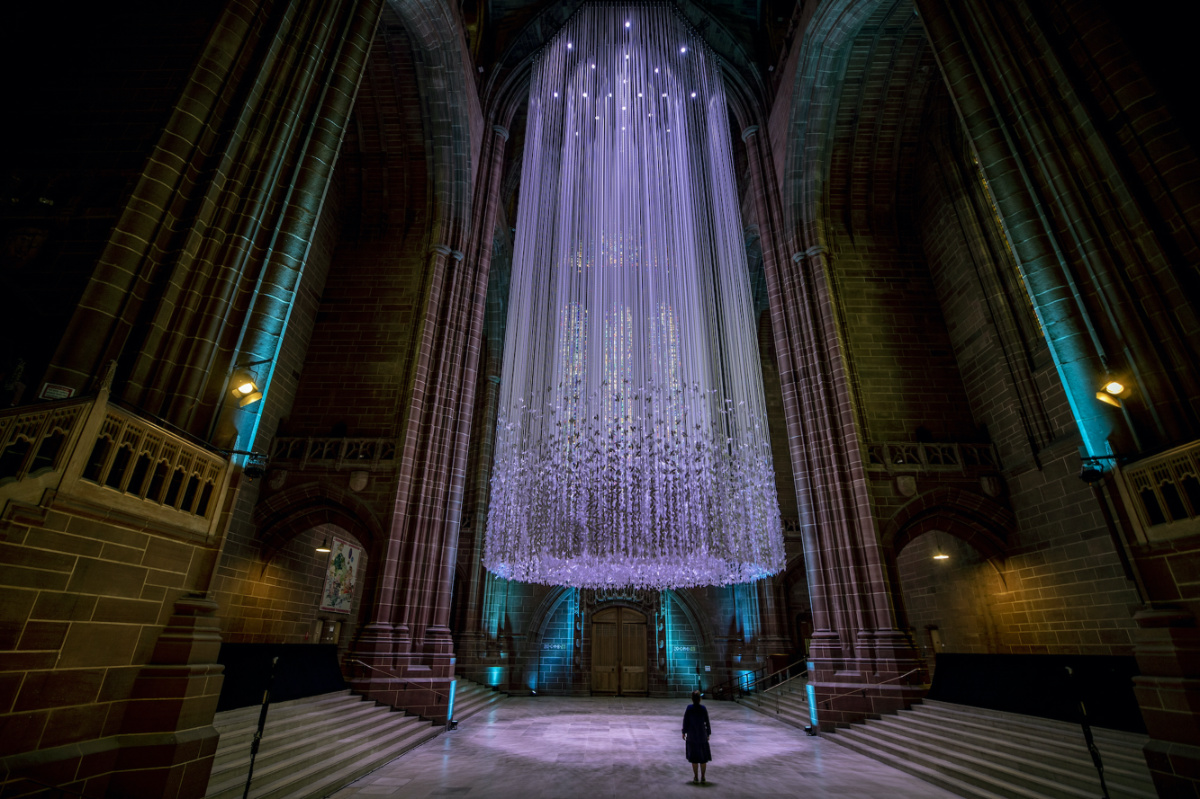
Sculpture Peter Walker’s work, ‘Peace doves’, in Liverpool Cathedral. PICTURE: Supplied.
Other recent displays at cathedrals include artist Mark Reed’s giant Wave sculpture at Norwich Cathedral. Shimmering with fish, it was exhibited just prior to the COP26 gathering in Glasgow, Scotland, late last year, and encouraged visitors to consider the power of the sea, and our dependence on healthy waters, often resulting in people leaving in tears. The base of the sculpture took visitors from a polluted seabed to pristine prehistoric sands, resulting in school children attempting to move the rubbish because they thought it shouldn’t be there.
One of the most dramatic contemporary art installations of recent years has been artist Luke Jerman’s Museum of the Moon, which has been exhibited in countless venues including Chichester Cathedral. Durham Cathedral hosted it between September and November last year during which time more than 90,500 people came to see it, with 9,000 of them booking special events including organ recitals, star gazing and silent discos. Visitors described it as “awe-inspiring”, “spiritual” and “reflective”.
The Very Rev Andrew Tremlett, Dean of Durham, says the installation has formed “part of the life of our living, working cathedral – at the centre of special events, a presence during services, both in the cathedral and online, and has also given a focal point for reflecting on current events”.
“The sense of awe and wonder the monumental scale of the Museum of the Moon instills was visible during the hourly prayers, led by the daily chaplain, who reported children sitting under the moon or in the front pews, joining in the recitation of the Lord’s Prayer – in fact, leading their parents to do so.”
That’s just one more example of how cathedrals in the UK are reclaiming their artistic heritage, expressing it new ways that are resonating with people of all faiths and none, bringing inspiration and hope to a new generation.





